Content
Perennial verbena (Verbena) is a herb from the Verbenaceae family. Its homeland is the tropics and subtropics of the American continent, so it is quite sensitive to the correct agricultural techniques and climate. Florists who decide to breed this magnificent flower with a pleasant aroma on their site need to know the basic principles of planting and care, as well as the characteristics of zoned varieties. Only with proper care will the plants be strong, pleasing the eye with their beauty throughout the warm season. Photos of perennial Verbena flowers will help you determine the variety.
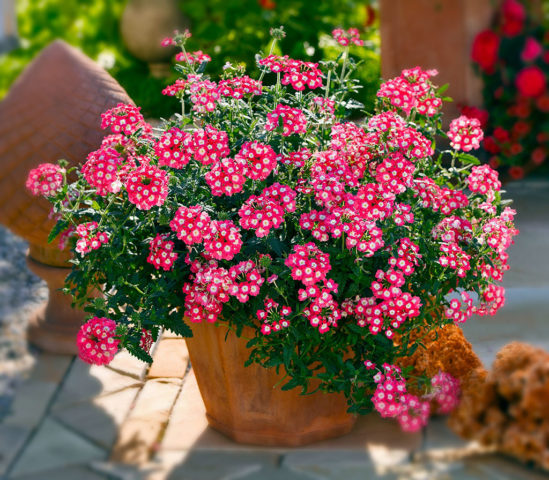
Ampel perennial verbena feels great both in pots and as a ground cover plant
General description of perennial verbena
Verbena is a perennial flower of a herbaceous or semi-shrub type. The stem is tetrahedral, can be erect or creeping, covered with soft bristles. The leaves are arranged in pairs, elongated-oval, pinnately-toothed, with a dense edge, bright green. Small cup-shaped flowers are collected in spherical or elongated inflorescences like a spear. The color of the petals can be very diverse, depending on the variety. The seeds are small, located in four sections of the nut-fruit. Perennial blooms from early summer to October.
Types and varieties of perennial verbena
In ornamental gardening, about four dozen varieties are used, bred by breeders from wild-growing counterparts. In nature, there are up to 200 species of this plant.
Buenos Aires
This perennial is also called "Bonar" verbena. It differs markedly from other varieties with its small flowers, collected in umbrella-shaped inflorescences. This tall, perennial verbena reaches 120 cm and does not require the installation of supports or a garter. The aroma of pale amethyst flowers is very delicate, powdery sweet. It does not tolerate frosts, therefore, in the northern regions in the open field, this perennial is grown for one season.
Perennial flowers of Buenos Aires verbena are shown in the photo.

Bonar verbena loves the sun, so it is advisable to plant it in open areas on the south side
Hard
Verbena hard is a perennial plant. It got its name because of the dense, rough, like emery, elongated spear-shaped leaves with jagged edges. Low, creeping, the average height of the bushes is up to 35 cm. Small lilac flowers, from light pastel to deep purple shades, are collected in spike-shaped inflorescences with two additional shoots on the sides. In warm climates, perennials feel good outdoors.

To preserve the plant for the next year in the northern regions, the rhizomes are dug up in the fall and placed in boxes with wet sand.
Straight
Verbena straight (stricta) is a stunning perennial in its beauty. Vigorous bushes end in large, highly elongated inflorescences at a height of up to 1.5 m. Deep purple, blue and lavender flowers are relatively small in size. The leaves of the plant reach 8-10 cm in length. Drought-resistant and undemanding to soil fertility, prefers slightly acidic soils. The flowering period is about 45 days.
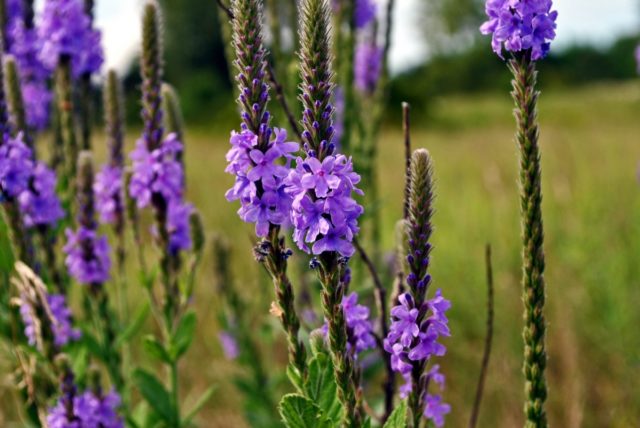
Verbena straight grows well in temperate climates with shelter for the winter
Hybrid
An excellent variety, most popular among flower growers. It is characterized by a variety of colors, unusual shapes of inflorescences, and their large sizes. Stems are highly branched, can spread along the ground.
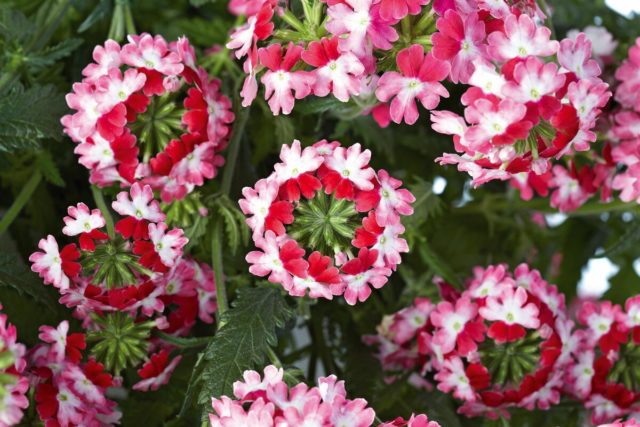
The hybrid perennial has a pleasant aroma that intensifies at sunset
Lance-shaped
Verbena spear-shaped grows up to 1.5 m. A very graceful plant with elongated inflorescences of tight pinkish, blue, white and lilac small flowers. Loves moist soils rich in minerals. An excellent honey plant, can be used to attract bees in the garden, in landscape design.

The homeland of the flower is the swamps and flood meadows of North America
Application in landscape design
Due to the variety of species, perennial verbena looks spectacular as part of landscape compositions. Tall dwarf shrubs are perfectly combined with greens, creeping perennials. From ampel varieties, you can make graceful balcony, wall decorations, plant them in large flowerpots and hanging pots. From the creeping species, an amazing carpet is obtained, pleasing with a riot of colors and a subtle aroma all summer and part of autumn.
Photos of perennial verbena flowers in a flower bed are presented below.
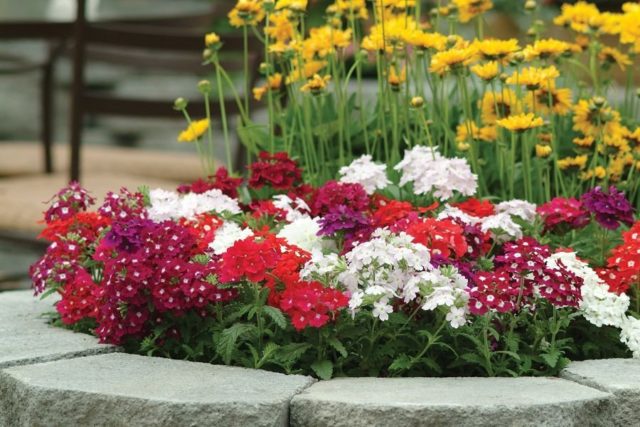
Verbena goes well with various types of garden flowers
Planting and caring for perennial verbena outdoors
Verbena is a perennial unpretentious to the composition of the soil, so planting and caring for it in the open field is not difficult. Even novice florists can cope with the task if you follow the rules of agricultural technology.
Perennial verbena can be grown in three ways, each with its own pros and cons.
- Seeds in the ground. The least reliable method, since germination sometimes does not exceed 30%, and tender young shoots are sensitive to negative environmental conditions. Therefore, there is a great risk of being left without flowers.
- Seedlings. A common method that ensures good germination of seeds and maximum safety of seedlings in the most critical period for plants.
- Cuttings. Perennial verbena reproduces well in this way. In the spring, the tops with 4-6 leaves are cut off, treated with an antifungal drug and a root formation stimulant. After that, the cuttings can be planted in the prepared soil. They should take root in a month. As soon as the shoots begin to grow, it is recommended to plant them in a permanent place.
Planting and caring for perennial verbena in the garden takes effort.
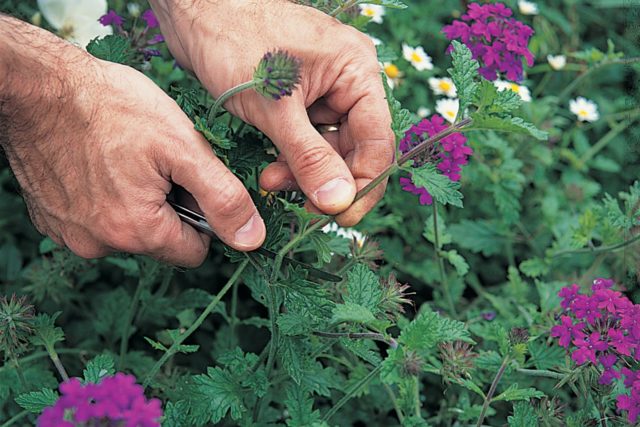
Cuttings are one of the most common breeding methods for perennial verbena.
Recommended timing
Sowing seeds for seedlings is carried out in early March. You can take individual peat cups, boxes, containers. The soil should be light, loose. Seeds must be scattered over the surface, slightly sprinkled with sand, moistened with a spray bottle.
A pick is made when 2-3 leaves appear, when the sprout reaches 7-10 cm in height. Seedlings can be planted in the soil if the threat of spring frosts has passed. This is usually early to mid-May.
Site selection and soil preparation
Perennial verbena is undemanding to the chemical composition of the soil. However, she prefers well-lit areas with light soil.If the earth is heavy, for example, clay, then sand or any other baking powder should be added to it, and also take care of drainage from rubble, expanded clay, brick chips. The perennial perfectly tolerates drought, but it is very sensitive to groundwater and stagnant waters, so it is necessary to choose high places where there is no threat of flooding.
How to plant perennial verbena
The distance between the bushes of low-growing verbena species is 20 cm. Large and creeping species should be 35-50 cm apart from each other. If the soil is dry, it should be pre-moistened by pouring warm water into each hole to the state of liquid mud.
Plants should be transplanted carefully, without disturbing the earthen lump - this way they will take root faster. After planting, lightly tamp the earth around, sprinkle with mulch. Water daily for 10-15 days, little by little, avoiding stagnant water.
Perennial Verbena Care
Plant care is standard for garden flowers. Perennial vervain is not capricious, and with the right choice of place, feeding and watering, it does not cause problems for gardeners. If the plantings are heavily thickened, you can thin them out and dive to give enough light for all the bushes.
Watering and feeding
The first thing to remember when cultivating perennial verbena is that it does not like waterlogged soil. A severe drought affects its growth and the splendor of the inflorescences. You should adhere to the golden mean, watering as needed, as soon as the earth begins to dry out, but not flooding. The frequency of watering depends on the climate - if the summer is rainy, it may not be necessary at all.
Frequent feeding is not necessary. If the soil substrate is initially rich in minerals and organic matter, then it is enough to saturate with complex fertilizers 2-3 times per season, without exceeding the recommended doses.
Loosening, weeding, mulching
Perennial verbena practically does not need weeding. Dense foliage covers the ground with a dense carpet, under which other plants cannot survive. The procedure is carried out as weeds appear.
Loosening for this perennial is not necessary, but desirable. So the roots receive additional oxygen supply. It is carried out several times per season, after watering or weeding. Then the loosened soil must be mulched with chopped straw, pine waste, bark, cones, humus or peat.
Wintering
For the winter in the northern and temperate Russian climate, perennial vervain must be wrapped or transferred to cool heated rooms with a temperature of 5-10 degrees. In the open field, the plants are cut and covered with spruce branches, then a good layer of snow is added, at least 30 cm. You can dig up the roots and store them in boxes of wet sand in the basement or cellar. And the plants in flowerpots must be brought into the utility rooms, on the veranda, and on the balcony without fail. Wintering lasts until the end of February-early March, then new shoots begin to appear.
Pests and diseases
Proper care allows perennial vervain to successfully resist various diseases. In case of unfavorable conditions, such as abundant watering or, on the contrary, drought, flowers are susceptible to powdery mildew, fusarium. In such cases, treatment with antifungal drugs is necessary.
Verbena is susceptible to attacks by aphids, sucking and leaf-eating insects, but quite rarely. If pests are found, they should be treated with an appropriate insecticide.
Conclusion
Perennial verbena is a magnificent flower popular among Russian gardeners. Lush variety, enchanting scent and long flowering period have made her the queen of home gardens. The plant is readily used for landscape design. It does not require special conditions, careful adherence to the feeding schedule and laborious care. In the temperate and northern latitudes of the Russian Federation, perennial vervain needs shelter for the winter.








